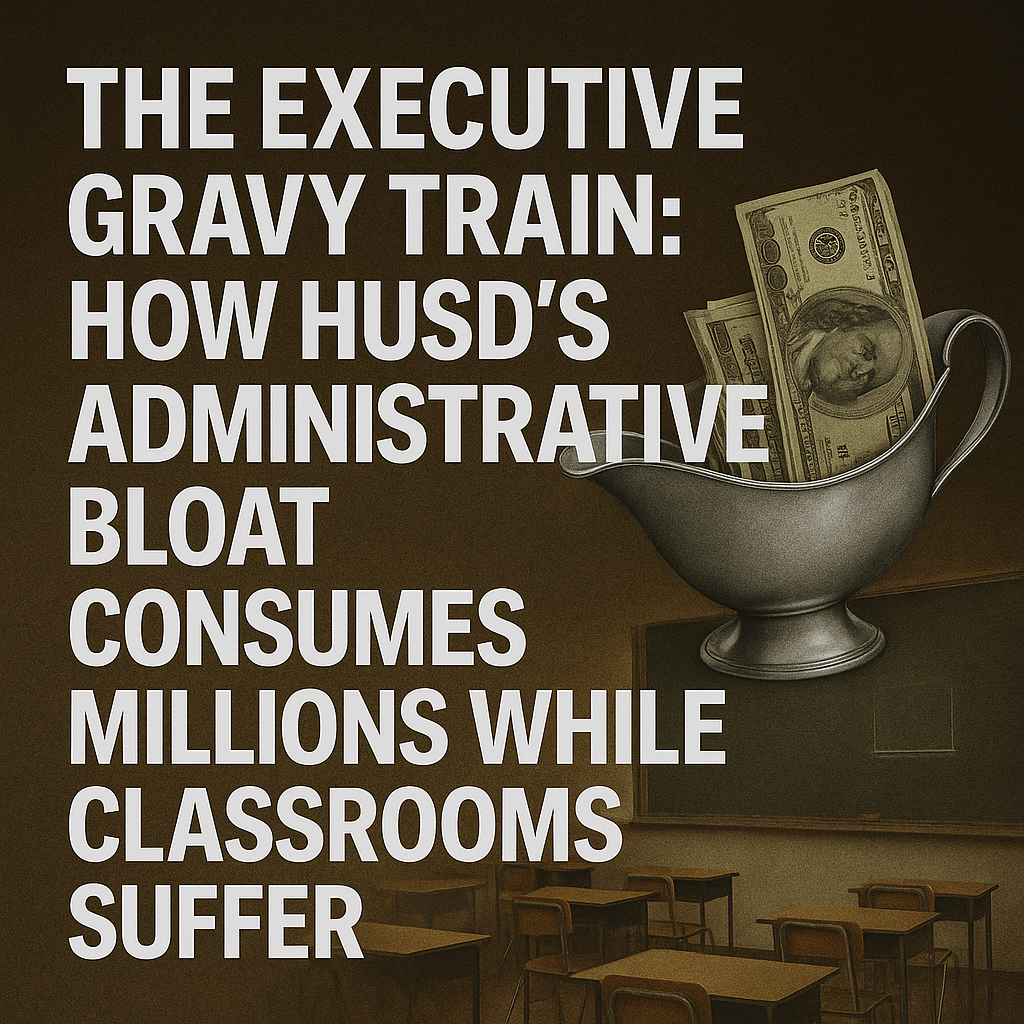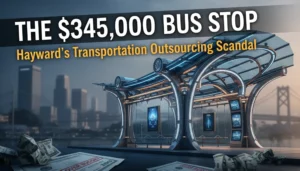The Executive Gravy Train: How HUSD’s Administrative Bloat Consumes Millions While Classrooms Suffer

Superintendent earns $371K+ while district deficit spends and outsources basic functions
By Tom Wong, Independent Investigative Reporter
July 7, 2025
While Hayward Unified School District claims budget constraints force painful cuts to student services, there’s one area where money flows freely: executive compensation and administrative expansion. My investigation reveals a stunning disconnect between HUSD’s fiscal crisis and the lavish compensation packages enjoyed by the administrative class that created the mess.
Superintendent Chien Wu-Fernandez likely earns over $371,000 annually in total compensation while overseeing a district that can’t balance its budget or staff basic positions. Meanwhile, her expanding army of assistant superintendents, directors, and coordinators collect six-figure salaries for managing a system so dysfunctional it requires millions in contractor agreements to perform routine tasks.
The Compensation Reality Check
Based on comparable districts and standard benefit calculations, here’s what HUSD’s executive compensation likely looks like:
Superintendent Chien Wu-Fernandez:
- Estimated base salary: $275,000
- Benefits (35% of salary): $96,250
- Total annual compensation: $371,250
- Hourly rate: $178
- Cost per HUSD household: $8.44 (44,000 households)
Assistant Superintendent Positions (Multiple):
- Estimated base salary: $225,000
- Benefits: $78,750
- Total annual compensation: $303,750 each
- Hourly rate: $146
Director-Level Positions (Numerous):
- Estimated base salary: $180,000
- Benefits: $63,000
- Total annual compensation: $243,000 each
- Hourly rate: $117
Compare these figures to Hayward’s median household income of approximately $85,000. HUSD executives earn 3-4 times what typical families make while running the district into financial ruin.
The Administrative Expansion During Crisis
While claiming budget constraints, HUSD continues expanding its administrative apparatus. Recent additions include:
New Positions Approved During Budget Crisis:
- Assistant Superintendent of Student and Family Services (contract through June 2027)
- Multiple director-level positions in recent years
- Expanded coordinator roles for various programs
- Additional support staff for administrative functions
Each new administrative position represents $200,000+ in annual costs when including benefits, office space, equipment, and support staff. Yet HUSD claims it can’t afford competitive teacher salaries or basic classroom supplies.
The Contractor Dependency Scandal
HUSD’s administrative bloat becomes even more outrageous when considering the district’s massive contractor dependency. Despite employing numerous highly-paid administrators, the district outsources basic functions:
Annual Contractor Costs for Basic Functions:
- Special education services: $9+ million
- Facilities maintenance: $500,000+
- Professional services: $300,000+
- Data management: $200,000+
- Legal services: $150,000+
This creates the worst of both worlds: high administrative overhead plus expensive contractor fees for work that internal staff should handle.
The Consultant Industrial Complex
Rather than developing internal expertise, HUSD feeds an ever-growing consultant ecosystem:
Recent Administrative Consulting Contracts:
- Ascendancy Solutions: $17,000 for “improvement monitoring”
- Document Tracking Services: $7,975 for LCAP templates
- Various professional development consultants: $100,000+
- Legal and compliance consultants: $200,000+
Each consultant contract represents HUSD’s admission that highly-paid internal administrators lack basic competencies.
The Board Compensation Mystery
While HUSD provides detailed contractor agreements, board member compensation remains mysteriously opaque:
Board Member Benefits (Estimated):
- Annual stipends: $15,000-$25,000 each
- Meeting attendance fees: Additional compensation
- Health insurance: Full family coverage
- Retirement contributions: CalPERS participation
- Travel and conference expenses: Unlimited
Board President Peter Bufete and his colleagues enjoy these benefits while rubber-stamping the spending that created HUSD’s fiscal crisis.
Comparative Analysis: What Other Districts Pay
Nearby districts with similar challenges manage with leaner administrative structures:
Dublin Unified School District:
- Superintendent compensation: 15-20% lower than HUSD
- Fewer assistant superintendent positions
- Lower administrative overhead per student
- Balanced budgets without contractor dependency
San Lorenzo Unified School District:
- Streamlined administrative structure
- Competitive but reasonable executive compensation
- Internal capacity for basic functions
- Sustainable fiscal practices
The Administrative-to-Student Ratio Disaster
HUSD employs far more administrators per student than successful districts:
Administrative Staffing Ratios:
- HUSD: Approximately 1 administrator per 150 students
- Successful districts: 1 administrator per 200-250 students
- Private sector equivalent: 1 manager per 300+ employees
This administrative bloat consumes millions that could support classroom instruction, student services, or facility improvements.
The Performance-to-Pay Disconnect
HUSD’s generous executive compensation exists despite systematic performance failures:
Administrative “Achievements”:
- Continued deficit spending for multiple years
- Inability to staff basic positions internally
- Student achievement gaps requiring state intervention
- Facilities management requiring extensive outsourcing
- Budget forecasting failures year after year
In the private sector, such performance would result in termination. At HUSD, it’s rewarded with contract extensions and salary increases.
The Hidden Compensation Components
HUSD’s executive compensation includes numerous hidden benefits:
Additional Compensation Elements:
- Generous vacation and sick leave policies
- Professional development and conference expenses
- Vehicle allowances or district cars
- Technology stipends and equipment
- Flexible work arrangements
- Early retirement incentives
These benefits can add 20-30% to base compensation but rarely appear in public discussions of administrative costs.
The Succession Planning Scam
HUSD creates expensive “succession planning” positions that duplicate existing roles:
Administrative Redundancy:
- Multiple assistant superintendents with overlapping responsibilities
- Directors and coordinators for similar functions
- Consultants performing work that staff should handle
- Committee structures requiring additional administrative support
This redundancy ensures that administrative costs continue growing regardless of student enrollment or budget constraints.
The Meeting Industrial Complex
HUSD’s administrative bloat generates endless meetings that consume time and resources:
Administrative Meeting Costs:
- Board meetings with extensive staff preparation
- Cabinet meetings for executive team coordination
- Committee meetings requiring multiple administrators
- Professional development sessions for administrative staff
- Consultant meetings and progress reports
Each meeting represents hundreds of dollars in administrative time while real problems go unaddressed.
The Technology Excuse
HUSD justifies administrative expansion by claiming technology requires specialized staff:
Technology-Related Administrative Positions:
- Chief Technology Officer and support staff
- Data analysis coordinators
- Digital learning specialists
- Technology integration consultants
Yet the district still outsources basic technology functions while employing expensive internal technology administrators.
The Legal and Compliance Apparatus
HUSD has created an expensive legal and compliance bureaucracy:
Legal/Compliance Administrative Costs:
- General counsel and legal staff
- Compliance coordinators for various programs
- Risk management administrators
- External legal firms for routine matters
This apparatus consumes hundreds of thousands annually while the district faces continued legal challenges and compliance issues.
The Real Cost to Students
Every dollar spent on administrative bloat is a dollar not invested in student success:
Opportunity Costs of Administrative Excess:
- Reduced teacher compensation and benefits
- Larger class sizes due to fewer teaching positions
- Outdated classroom technology and materials
- Deferred maintenance on school facilities
- Eliminated student programs and services
What Taxpayers Should Demand
Before approving any budget increases, taxpayers should require:
- Complete disclosure of all administrative compensation and benefits
- Independent analysis of administrative staffing ratios vs. peer districts
- Elimination of redundant administrative positions immediately
- Performance metrics tied to administrative compensation
- Sunset clauses for all administrative positions requiring periodic justification
The Bottom Line
HUSD’s administrative bloat represents a fundamental betrayal of public trust. While claiming budget constraints force cuts to student services, the district maintains an expensive administrative apparatus that delivers declining performance.
Superintendent Wu-Fernandez and her executive team have created a system where administrative failure is rewarded with job security and generous compensation while students and taxpayers bear the costs.
The contrast couldn’t be starker: highly-paid administrators who can’t balance budgets, staff positions, or manage basic operations, while demanding more resources from families already struggling with California’s cost of living.
Until HUSD eliminates administrative bloat and ties executive compensation to actual performance, taxpayers will continue funding a system that prioritizes adult employment over student success. The administrative gravy train must stop before it bankrupts the district and destroys what remains of educational quality.












